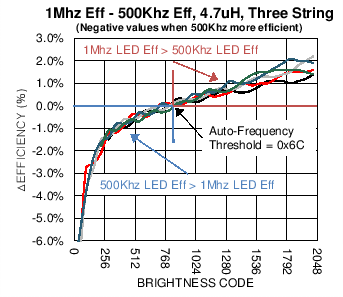SNOSCS2D November 2013 – March 2019 LM3697
PRODUCTION DATA.
- 1 Features
- 2 Applications
- 3 Description
- 4 Revision History
- 5 Pin Configuration and Functions
- 6 Specifications
-
7 Detailed Description
- 7.1 Overview
- 7.2 Functional Block Diagram
- 7.3 Feature Descriptions
- 7.4 Device Functional Modes
- 7.5 Register Maps
- 8 Application and Implementation
- 9 Power Supply Recommendations
- 10Layout
- 11Device and Documentation Support
- 12Mechanical, Packaging, and Orderable Information
Package Options
Refer to the PDF data sheet for device specific package drawings
Mechanical Data (Package|Pins)
- YFQ|12
Thermal pad, mechanical data (Package|Pins)
Orderable Information
7.3.3 Automatic Switching Frequency Shift
The LM3697 has an automatic frequency select mode (bit 3 in the Boost Control register) to optimize the frequency vs load dependent losses. In Auto-Frequency mode the boost converter switching frequency is changed based on the high-voltage LED current. The threshold (Control A/B brightness code) at which the frequency switchover occurs is configurable via the Auto-Frequency Threshold register. The Auto-Frequency Threshold register contains an 8-bit code which is compared to the 8 MSB's of the brightness code. When the brightness code is greater than the Auto-Frequency Threshold value the boost converter switching frequency is 1 MHz. When the brightness code is less than or equal to the Auto-Frequency Threshold register the boost converter switching frequency is 500 kHz.
Figure 8 illustrates the LED efficiency improvement (3p5s LED configuration with a 4.7-µH inductor) when the Auto-Frequency feature is enabled. When the LED brightness is less than or equal to 0x6C, the switching frequency is 500 kHz, and it improves the LED efficiency by up to 6%. When the LED brightness is greater than 0x6C, the switching frequency is 1 MHz, and it improves LED efficiency by up to 2.2%.
Table 1 summarizes the general recommendations for Auto-Frequency Threshold setting vs Inductance values and LED string configurations. These are general recommendations — the optimum Auto-Frequency Threshold setting must be evaluated for each application.
Table 1. Auto-Frequency Threshold Settings
| THREE STRING | TWO STRING | |||||
|---|---|---|---|---|---|---|
| INDUCTOR | AUTO-FREQUENCY THRESHOLD | PEAK EFFICIENCY IMPROVEMENT | PEAK CONFIGURATION | AUTO-FREQUENCY THRESHOLD | PEAK EFFICIENCY IMPROVEMENT | PEAK CONFIGURATION |
| 4.7 µH | 6C | 2.2% | 3p5s | AC | 1.1% | 2p6s |
| 10 µH | 74 | 1.7% | 3p4s | B4 | 1.3% | 2p5s |
| 22 µH | 7C | 0.7% | 3p3s | BC | 0.7% | 2p4s |
